- Polka Dot Begonia: What Can You Do To Keep This Plant Healthy? - September 14, 2021
- Ficus Microcarpa: Why Is This A Must Have Plant? - September 13, 2021
- Begonia Ferox: How Long It Takes For Begoniaceae To Sprout? - August 24, 2021
Pothos (Epipremnum aureum) is a popular houseplant species of vines native of French Polynesia’s Mo’rea, and the plant boasts beautiful cultivars and varieties. Several growers refer to it as devil’s ivy, taro vine, ivy arum, or Ceylon creeper, with its low maintenance requirements making it popular as an indoor plant.
No wonder many people see it as their favorite in hanging baskets, shelves, or drape cupboards because of its trailing stems with heart-shaped leaves.
Pothos has one biological species. However, many horticulturists have developed various species, which are only cultivars since no pothos hybrids exist. The classical golden pothos and Marble Queen are among the 12 notable species for their excellent decorative value.
While pothos is different, they all share similar characteristics. Therefore, our team has done the necessary research to help you identify each pothos type with helpful information and tips on this favorite houseplant. Pothos varieties require similar primary care even with their differences. We encourage you to read on to know how to grow Pothos successfully.
Common Pothos Types and Varieties
Several novice growers start with one of the first houseplants, like pothos. The good reason they do this is that pothos is highly versatile and easy to care for. If you prefer pothos, you can also:
- Grow pothos horizontally on windowsills, mantles, or tabletops
- Grow the plant as a moss pole or plant totem
- Grow pothos in hanging containers, and the plant will cascade downward
You can even grow pothos in low light. However, brighter indoor spaces will give your plant healthy growth. You only need to ensure that the potting soil is not dripping wet but moist as it doesn’t need plenty of water. Essentially, pothos has several unique varieties, and you can easily have training beauty and colorful variegation with pothos jungle.
For this post, let’s discuss some of the pothos types and varieties.
Satin/Silver Pothos
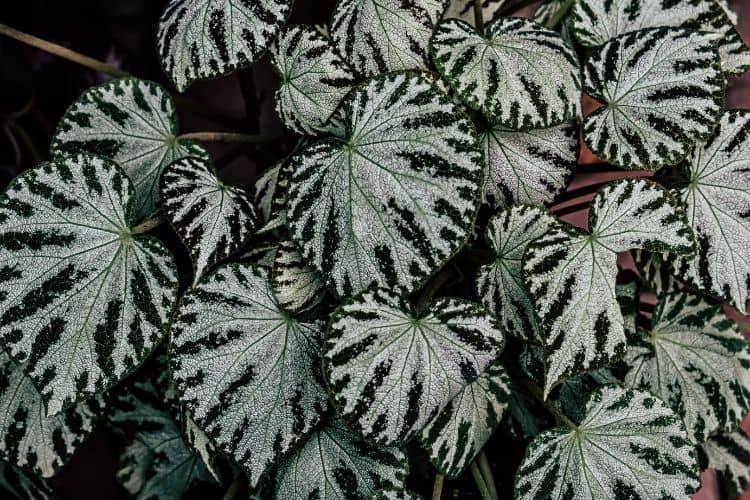
Satin or Silver Pothos boasts heart-shaped, gorgeous dark green foliage. You will notice a speckle of silver in the dark green leaves. Silver Pothos or Satin Pothos has small foliage than any other varieties.
Jade and Pearls Pothos
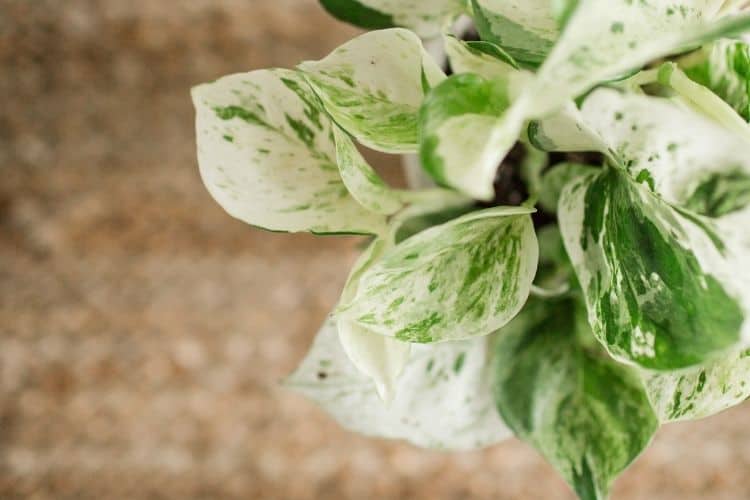
This pothos type is a patented pothos type, and the University of Florida produced it. Jade and Pearl Pothos have variegated green leaves with white and silver-gray hues. It is relatively easy to spot the pothos among various pothos types by identifying the plant’s variegation patterns at the edges. In addition, there are silver-gray and green shades in the whiter parts of the foliage.
Manjula Pothos
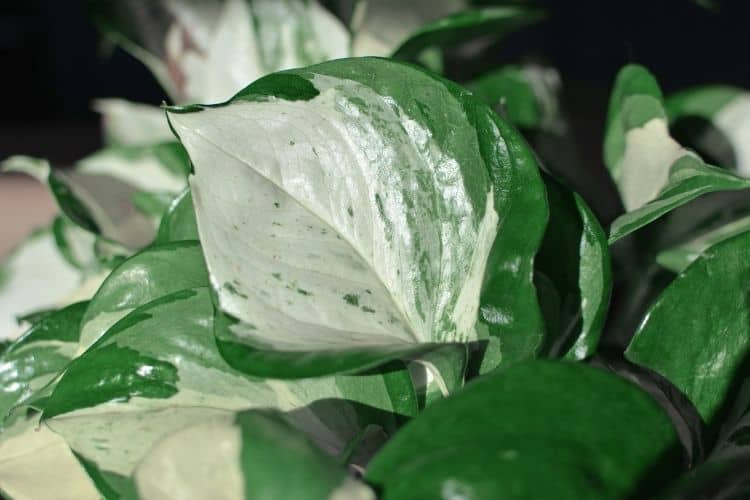
The University of Florida originally produced Manjula Pothos as a patented pothos variety. Manjula pothos is different from other pothos is the curvy edges of their heart-shaped leaves that cannot lay flat. In addition, there are hues of green, white, silver, and cream in its variegated leaves.
Jessenia Pothos
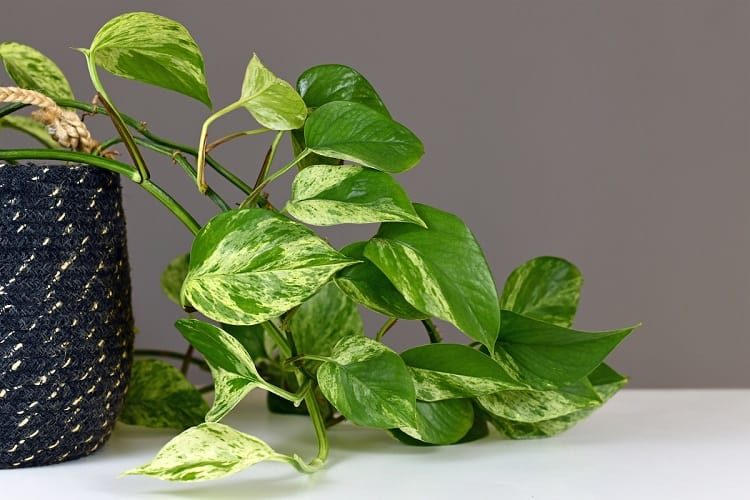
Jessenia Pothos features greenish-yellow hues and green heart-shaped foliage. Jessenia Pothos is similar to Marble Queen, with its leaves turning out different than the rest.
This pothos lacks chlorophyll, which makes it grows slower than non-variegated pothos. The main difference between Marble Queen and Jessenia Pothos is that Marble Queen’s limey-green variegation is white and lighter, while that of Jessenia is much darker.
Neon Pothos
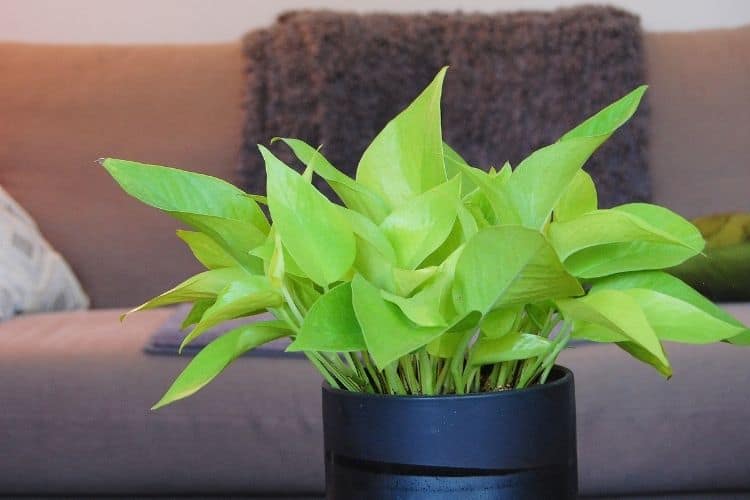
This pothos is unique with the lime-green, bright color of its heart-shaped leaves. You will notice more brilliant hues in its budding, younger leaves and a deep neon tinge on the mature, older leaves. When you grow Neon Pothos under bright light, you can expect the plant to give you that striking signature neon color!
How to Grow Pothos from Seed
No sane experienced grower will encourage you to attempt growing pothos from seed. You can only get flowers from mature plants and even seeds. However, the houseplants tend to be strictly juvenile. Thus, the process is unlike grabbing some seeds from a local seed swap or a neighbor.
Even with that, the seeds may not be easy to find since most of these sellers are not living in the US and even those available online are not up to par. In addition, it can be tricky to verify if the seeds are disease-free when they come from growers halfway around the world. Apart from that, knowing the specific species you bought is unlikely until they germinate, that is, if they do at all.
Moreso, there is no guarantee you would get the pothos you wanted. Most of the pothos types any houseplant enthusiasts see are derived from deep green, simple jade pothos. The leaves’ flecked patterns, which are variegations, are mutations from the solid green plant.
Thus, there is no guarantee that the seedlings will stay variegated when variegated plants produce seeds. It is essential to bear these factors in mind when buying seeds because the offspring may not be as exotic as the source plant.
It could lead to various plants when grown if you managed to acquire golden pothos seeds and plant them. These could be variegated, solid green, or somewhat in between.
Producing an albino plant is possible, which can most likely die since it cannot photosynthesize. In essence, it may not be enough sunlight when there are more white patterns on a variegated leaf. As such, the plant can only gather as much sunlight as possible by reverting to green in a low-light situation.
How to Propagate Pothos Plants
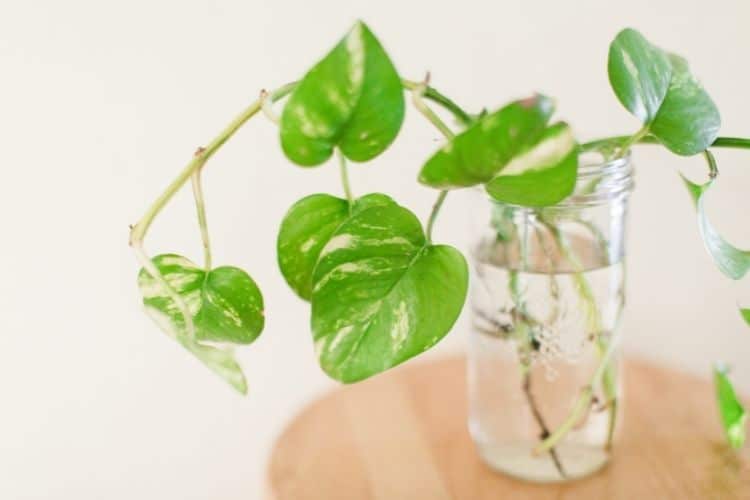
You will need about four- to six inches of solid stems from a mature vine for each potted pothos. Ensure you have about one node and four leaves on each piece. It is a bump where new growth occurs in the stems, including roots, aerial, or leaves. Get rid of the leaves close to the spot where you cut the stems.
Prepare a four-inch container of a mix of half peat, sand, or half perlite or pre-moistened potting soil, where you will place about three to four of these cuttings. Allow about an inch to two to space the cuttings, ensuring that each node rests beneath the growing medium surface. Avoid waterlogging, even as you keep your cuttings moist. Also, avoid direct sun and keep them in moderate light.
Sending down roots can take about four to six weeks for the cuttings. It will also take another month for the stems to develop root systems adequate to start their journeys as small plants.
You can also prepare a jelly glass and fill it with around four inches of warm tap water to place three to four cuttings when propagating root cuttings in water. Again, ensure that the node is not below the leaves but below the waterline.
Prepare a place with about moderate indirect light to place the jar. After three to six weeks, you will notice the roots showing. After about another month, you can plant three or four of them in a six-inch container when they have grown an inch or two.
Use the potting mix to fill each pot to about an inch below the rim and ensure a houseplant type. It is not wrong to add extra perlite to increase drainage.
Pothos Growing Conditions
One of the best things any grower can give to pothos is to provide the plant with sufficient light. Avoid putting your plant in direct sunlight. The sun can scald the leaves even if your window separates sunbeams and plants.
Another critical consideration is the temperature. If you are turning down your thermostat in less-used rooms in the cold months, you need to know that your plant doesn’t tolerate those cold spots in the house. Ensure to put pothos where you put on the heat during the winter. You also need to keep the plant out of the drafts’ range as well.
Temperatures between 65 degrees to 90 degrees are perfect for these houseplants, whether you put them out on the deck or patio for the warm months in your area or they live full time indoors.
If you adjust the thermostat as low as 55 degrees, pothos will survive. However, you may begin to sacrifice growth and look pretty quickly. In other words, it may not work for the long-term, except if you are on vacation.
Water pothos regularly, and you can expect the plant to grow more quickly. You must ensure that the soil dries out entirely between hydration sessions. Dip one or two fingers into the soil to check this. It must be scorched at about an inch down.
As an alternative, wait till your pothos tells you that it needs water before watering it. Room temperature water is adequate. Then, when watering the plant, do that around the stems’ base and not from the leaves above. With that, you can avoid some plant diseases.
How to Plant Pothos

Now that you have finally got a houseplant that is almost impossible to kill, allow us to congratulate you! You will need to adopt a few strategies to keep your pothos alive and healthy.
Let the pothos be in the container they came in when you bought them. However, ensure that the pot has drainage holes with a well-draining growing mode. Also, ensure that your pothos is not growing in garden-variety soil that can be compacted or soggy if you get the plant from a garage sale or a friend.
Pothos can survive just about anything. However, these plants cannot hack too much wet feet or moisture from undrained soil. Give your new-to-you houseplant an excellent start in a container or pot of well-draining, new potting mix if you plan to plant a cutting.
We recommend getting a mixture with some perlite, vermiculite, or peat moss in it. Ensure to clean your hands when mixing them in a freshly washed, separate pot with an airtight lid. You can also prepare a gallon-sized zipper storage bag for it. With that, you will have a dry, cool spot to store any extra.
Do your pothos a favor by skipping unsterilized potting mix. Instead, you must prepare a dish or tray to take excess water if you don’t get your new plant on time.
Also, prepare a suitable space for the plant to grow. Don’t get caught up with the bragging about how pothos can survive with little to no illumination to put it in a spot with low light. Pothos likes moderate light levels or indirect, bright light. You won’t have any cool variegation and will have an all green jazzy houseplant when you give it too little light. The plant can even quit growing.
Indoor Planting Method
When you plan to grow pothos indoors, you will find it one of the easiest houseplants to grow when following these simple steps and care guidelines.
- Prepare well-drained potting soil to plant pothos. Good drainage is the critical soil requirement for pothos, and you will see any well-drained, high-quality potting mix or potting soil do the magic. We encourage mixing perlite into your soil before planting for an even higher drainage capacity.
- Get indirect, bright light for your pothos. Though low light conditions are suitable for pothos plants, they can have fade leaf variegation when you put them in the shade for long. Ensure to put your pothos in indirect light for a thriving plant with variegated, vibrant leaves. Also, keep your photos away from direct sunlight to prevent from having discolored or scorched leaves.
- The soil’s top inch needs to dry out between watering periods to know that you can provide more water for the plant. Pothos leaves can start to wilt when you wait too long. It is also a sign that you overwater the plant when you notice yellow leaves.
The lush green variegated pothos leaves will beautify your interior, and since it is easy, low-maintenance vines cascading down, you can plant your pothos in a hanging basket. You can even grow pothos indoors in cool glass containers, mason jars, or fishbowls.
Outdoor Planting Method
It is logical to assume that you can plant pothos in your garden if you live in a region with USDA zones 10 to 12. However, if that is not the case, you may need to grow pothos in the container or grow them as a houseplant as temperatures cool by taking them outdoors for the warmer months.
You must have noticed pothos winding around file cabinets or walls if you live or work in a commercial office building. Fluorescent lighting is suitable for pothos, which makes them perfect for these situations.
As an understory plant, pothos hails from a tropical region, and the plant requires warm temperatures and tolerates shaded location like a place with minimal dappled morning light. Therefore, the plant prefers 70 to 90 degrees temperatures with high humidity when planted outside.
Essentially, pothos can grow sufficiently with any soil type.
You can let your pothos climb up trellises and trees in the garden. It can also meander through the garden space. As such, you can prune to delay or check its size. Ensure that you allow the pothos soil to dry between watering periods and never allow your pothos to stand in water. You can water your plant again after letting the top two inches of the soil dry.
Whether you plant pothos indoors or outdoors, it is easy to care for the plant since you will deal with a few pest or disease issues. However, with that, the plant can be susceptible to scale or mealybugs. Still, you can easily eradicate the pest in no time by dipping a cotton ball in a horticultural treatment or alcohol.
Pothos Potting & Soil
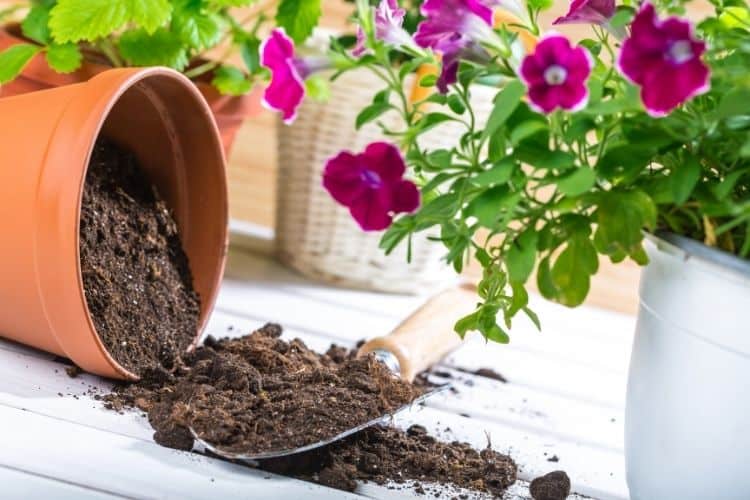
Pothos cannot tolerate sitting in water, and you will need to prepare containers with drainage holes for your plants. In addition, you will need to deal with a severe case of root rot, and the pothos will fail to grow if you allow the plant to sit in water too long.
Well-drained soil is suitable for pothos, and the soil may not nourish the roots but drown them if the soil does not drain well. You can consider buying a pre-mixed soil or mix your own. Any choice you choose must not be dense but lightweight with sufficient ample air space. Doing this will give room for efficient drainage and absorption.
Buying a Pre-Made Mix
The more and easier popular option is to get a high-quality potting mix from your local garden store. Try to get compounds with adequate aeration and perlite. These potting mixes are sterile as they are soilless, keeping fungi and pests away from your pothos.
While soilless mixes tend to be perfect for moisture absorption, the soil may get any organic nutrients from them, and you will have to add them.
Mixing Your Own
If you are looking for adequate nutrition and efficient drainage, you will need a balanced ingredient mixture. Therefore, most of all the following varieties must be in a good combination:
- Coco coir – It is a byproduct of the coconut tree as an organic compound. It complements the drainage, water retention, and absorbency of potting soil. Many growers often use it as a peat moss
- Compost – We recommend using compost for outdoor plants only as it adds nutrients to the soil.
- Shredded bark – it adds drainage and air pockets.
- Sand – growers use sand for air pockets and extra drainage.
- Perlite –can retain its shape as a naturally occurring mineral. It can also absorb water quickly and has pockets for air.
- Peat moss is perfect for oxygen and water retention as a partially decomposed soil layer in bogs.
- Vermiculite – aerates the soil while hydrating minerals used for nutrient and water absorption.
Pothos Water Requirements
Pothos will thrive well when appropriately watered. We recommend letting the soil mostly dry out between watering sessions. Poke your finger into the soil to ensure it is indeed dry. In addition, look for two to three reading to indicate that the plant needs a drink when you use a moisture meter to determine the moisture level.
When pothos is thirsty, it will droop slightly, which will remind you to water it when you forget to do so. Therefore, if you are looking to know how to water pothos and want to know whether to check the soil daily, we recommend taking cues from pothos instead of being stuck to a watering schedule. It is because several factors will affect your pothos’ watering requirements. Some of these factors include:
- Humidity and temperature
- How much light your pothos is getting
- Seasonal changes
You will possibly need to water your pothos every one to two weeks, based on these factors. Watering a little more or less may not make them throw a fit. However, your plant will look its best when you note the leaves and soil to know when it needs water.
Pothos Light Requirements
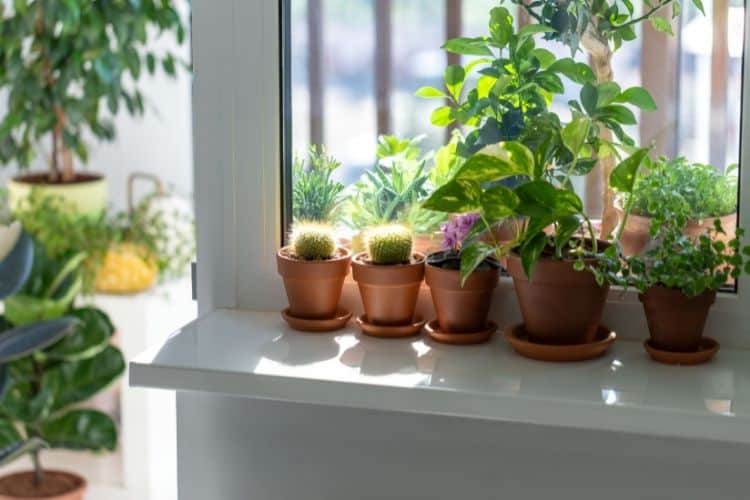
No matter where you place pothos in your house, it is a tough plant that grabs attention. If you know how the plant can tolerate low light, you need to know that the amount of light it gets can make a significant difference in how well it grows.
The bright, indirect light of about 12 to 14 hours a day is suitable for pothos. With that, your plant will have an ideal spot in east-facing doors or windows. Ensure that the plant does not get more than three to four hours a day of direct sunlight. You will know you are dealing with excessive light with sunburned and bleached-out leaves.
Too much or too little light will quickly stress the plant while you will enjoy the most elegant and lushest foliage from the ideal light. Conversely, when pothos gets poor light, it will look scraggly, stunted, or scruffy. Alternatively, excess light can scorch pothos, causing sunburn or bleach out the leaves.
You can also use these steps if you want a low-tech option to know the perfect light requirements for your pothos.
- Prepare the location where you will place your plant. You can lay a sheet of white paper on the spot.
- Position or hold your hand about one foot directly on the paper. Ensure to do this in the afternoon to get the most accurate test.
- Spread your fingers evenly and wide.
- You can then examine the shadow cast with your hand to know the more intense the light with the shadow cast by your hand.
Best Pothos Fertilizer
We recommend identifying your plant before fertilizing because some pothos plants are not indeed pothos. In essence, it is safe and effective to use some basic treatment options with all pothos varieties. It is also helpful to know that fertilizer is critical for pothos even though the plant is not a heavy feeder. The plant can be more vulnerable to disease and pests and lose vigor if it doesn’t get enough essential nutrients.
Fortunately, you can meet pothos’ nutritional needs by using a basic balanced houseplant. A balanced fertilizer adjusted to the proper frequency and dilution will work well for pothos. Follow the type of fertilizer’s requirement to feed the plant. Winter months are when the plant is dormant; as such, avoid using fertilizers.
The types of fertilizers you can use for pothos include:
- Slow-release
- Liquid
- Granular
- Composr
- Used coffee grounds
Best Pothos Companion Plantings
Jade Plant
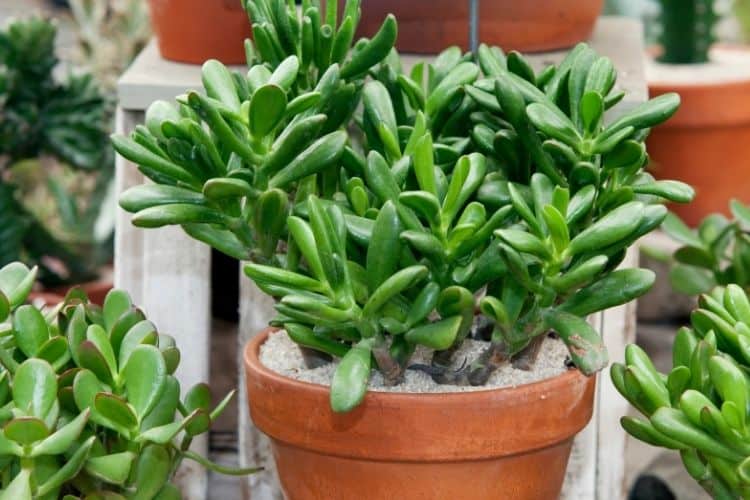
The jade plant will make an ideal combination with pothos, with its striking color and shiny or succulent leaves. The plant thrives on opposite sides, trailing along the stems.
Light Requirements
Jade requires plenty of light, and it can tolerate four hours a day in a west-facing or south-facing window.
Soil Requirements
Jade likes rocky, loose, well-draining soil, like most succulent plants.
Water Requirements
The plant does not grow well when sitting in constantly moist soil.
Pros
- Perfect for novice growers
- It has medicinal properties
- Absorbs CO2 during the night
Cons
- The plant is susceptible to edema
- Jade can be toxic to the pest
Butterfly Palm
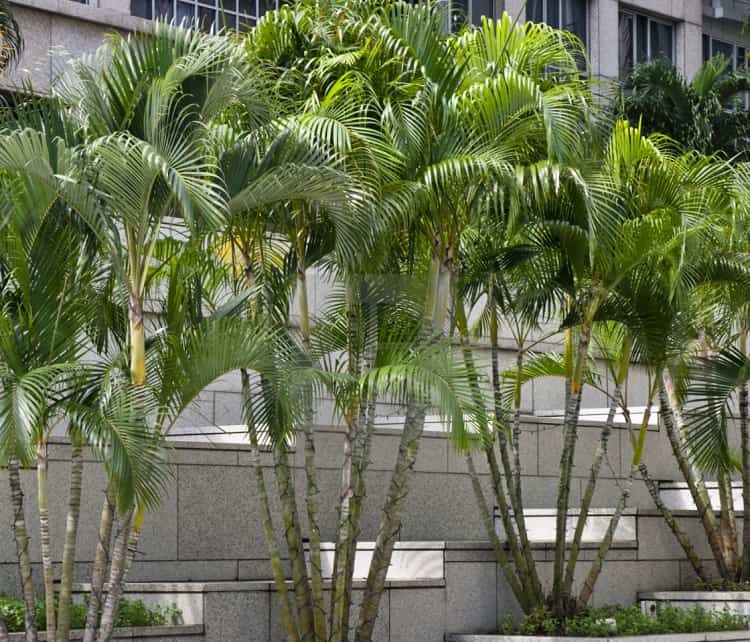
The Butterfly Palm has narrow leaflets with arching, tall fronds and will pair well with your pothos, apart from making an ideal addition to any interior by creating accents or framing furniture.
Light Requirement
Butterfly Palm will grow well in dappled sun or indirect, bright light.
Soil Requirements
The plant requires well-drained and light soils.
Water Requirements
Butterfly Palm is always thirst in summer, spring, autumn, or fall, and it will require heavy watering during those months.
Pros
- It beautifies the interior
- Safe for pets
- Emits more oxygen
- Absorbs indoor air-pollutants
Cons
- The plant can develop issues when grown indoors
Snake Plant

Any lazy grower will find Snake Plant ideal because of its low maintenance. In addition, the plant can survive comfortably in near darkness while withstanding almost any light condition variations.
Light Requirements
While Snake Plant can tolerate some direct sunlight, the plant prefers bright, indirect light.
Soil Requirements
The plant thrives well with a free-draining soil mix since they are susceptible to rot.
Water Requirements
It is okay to water the plant every two to three days.
Pros
- It is low maintenance
- It is efficient against allergies
- It eliminates air pollutants
- It looks stunning
Cons
- Regular fungus attack
- Leaves falling over
- It grows slow
Pothos Diseases and Common Problems
The most common insect problem for pothos is scale and mealybugs. You can notice scales as dark-colored bumps on leaves and stems, and mealybugs are like small cotton balls. These insects can redirect nutrients from leaves and reduce plant sap through their feeding activity. As such, the leaves can become stunted or distorted in high infestations.
Various reasons can cause pothos leaves to turn brown or yellow. Some of them include pothos is sitting in water, irregular watering patterns, and when grown in too little light. The entire plant will typically turn yellowish when the problem is overwatering. However, the foliage may look okay while the older leaves turn brown or yellow if the problem is uneven watering.
Pothos Treatment and Maintenance
When it comes to an understanding of how to grow pothos, the critical factor is maintenance. Your plant will become more and more rootbound as it gets bigger. It may not have more space to live, thrive, or grow to a healthy plant when the roots take up the container. It is now critical to repot. Prepare a larger container, get fresh potting soil, and put your pothos back in their place.
In essence, trimming off any dead, dry, or yellowing foliage is one of the best care to give your pothos. Unwanted pests can weaken the plant’s leaves and steal energy from new and healthy growth through dead foliage that attracts them. You can help pothos direct its energy and time to the parts that require it the most by trimming now and then.
Trimming will also help promote better health and new growth, even though pothos can get unruly when grown in the wild. The plant can get leggy, meaning sparse growth, looks a bit unkempt, and grows unevenly. The best solution is to prune off the untidy parts of the plant. We recommend using a sanitized, clean pair of shears.
Where to Buy Pothos Seeds Online
Pothos seeds are available online at:
Where to Buy Mature Pothos Online

Here are some of the online retailers selling mature pothos:
FAQs
Question: Why is Pothos Called Devil’s Ivy?
Answer: People call pothos devil’s ivy because the plant stays evergreen and almost impossible to kill even when grown in the dark.
Question: How Poisonous is Pothos?
Answer: Pothos sometimes can produce uncomfortable and severe side effects in people or animals, even though it is mildly harmful in small quantities.
Question: Is Pothos Called Money Plant?
Answer: Yes, they call the plant money plant, and growers commonly grow it as a hanging plant.
